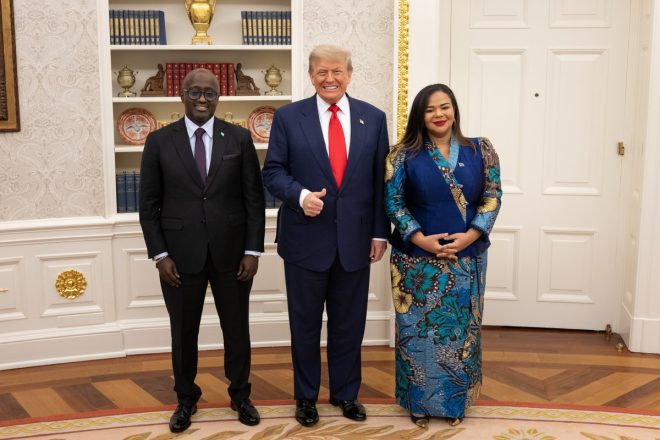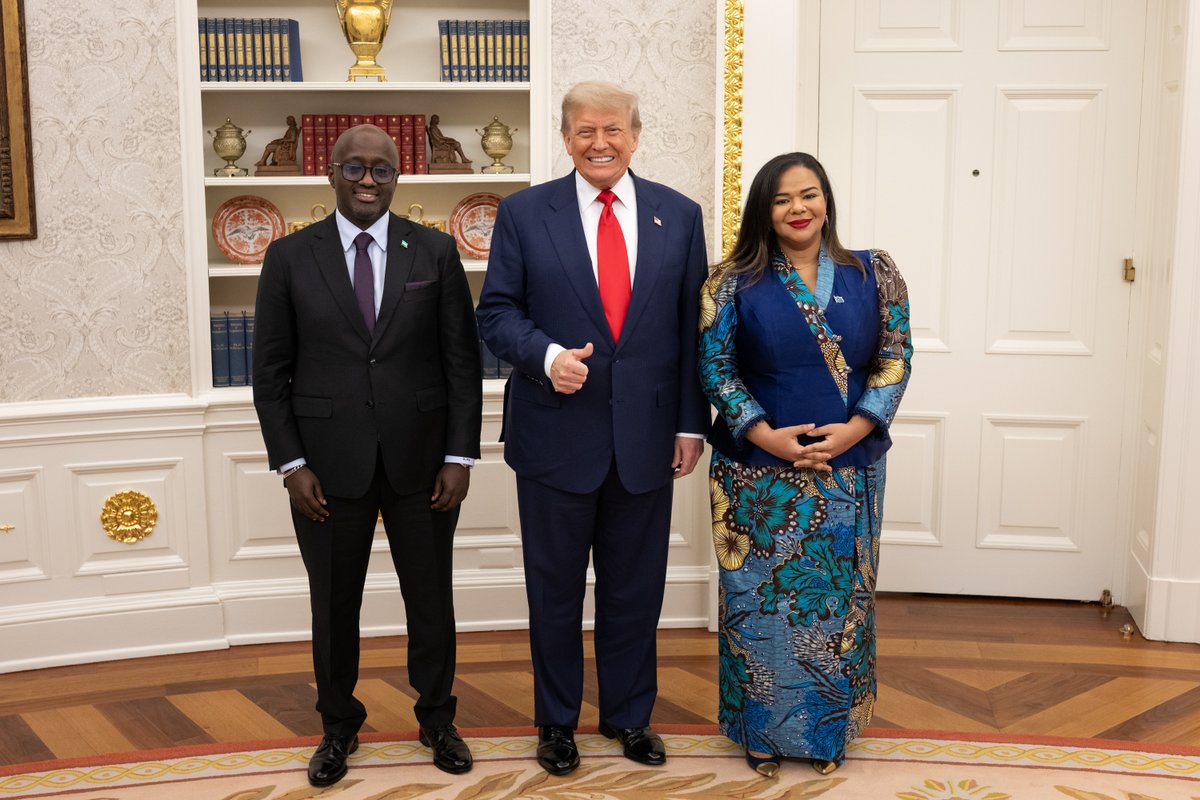
Trump’s Oval Office Peace Pact: Can 30 Years of Conflict Really End?
peace agreement Africa, diplomatic relations Rwanda Congo, conflict resolution strategies
—————–
Historic Peace Agreement Between Rwanda and the Democratic Republic of Congo
On June 27, 2025, a landmark moment unfolded in the Oval Office as President Donald trump welcomed the Foreign Ministers of Rwanda and the Democratic Republic of Congo (DRC). This significant event marked the signing of a peace agreement aimed at ending a conflict that has persisted for over 30 years in the region. The peace accord is a beacon of hope, signaling an end to violence and destruction that has plagued both nations for decades.
A New Era of Peace and Stability
President Trump emphasized the importance of this agreement, stating, "Today, the violence and destruction come to an end, and the entire region begins a new chapter of hope." This sentiment encapsulates the aspirations of not only the leaders involved but also the millions of people who have suffered due to the ongoing conflict. The peace agreement is expected to foster stability, encourage economic growth, and promote cooperation between Rwanda and the DRC, which have historically had tumultuous relations.
Background of the Conflict
The conflict in the Great Lakes region of Africa, particularly between Rwanda and the DRC, has deep historical roots. It has been characterized by ethnic tensions, political strife, and struggles for control over natural resources. The Rwandan Genocide in 1994 exacerbated these tensions, leading to the influx of refugees and further destabilization in the DRC. The involvement of various armed groups and foreign interventions has complicated the resolution of the conflict, making this peace agreement a crucial milestone.
- YOU MAY ALSO LIKE TO WATCH THIS TRENDING STORY ON YOUTUBE. Waverly Hills Hospital's Horror Story: The Most Haunted Room 502
Key Components of the Peace Agreement
The peace agreement encompasses several vital components aimed at ensuring long-term stability:
- Disarmament of Rebel Groups: Both nations have committed to disarming and demobilizing armed groups operating in the region. This step is essential for reducing violence and fostering a secure environment for civilians.
- Cooperation on Security: Rwanda and the DRC have agreed to enhance cooperation on security matters to prevent future conflicts. This includes sharing intelligence and conducting joint operations against remaining threats.
- Economic Collaboration: The agreement encourages economic collaboration between the two countries, promoting trade and investment opportunities. This economic integration is seen as a pathway to mutual prosperity and a means to address the underlying causes of conflict.
- Humanitarian Assistance: Recognizing the humanitarian crisis that has resulted from the conflict, the agreement outlines provisions for humanitarian assistance to affected communities. This includes access to healthcare, education, and basic needs for displaced persons.
- Dialogue and Reconciliation: A framework for ongoing dialogue and reconciliation efforts is established to address grievances and build trust between the communities of Rwanda and the DRC. This is vital for healing the wounds of the past and fostering a spirit of cooperation.
International Support and Implications
The signing of this peace agreement has garnered international attention and support. Various global leaders and organizations have expressed their endorsement, recognizing the potential for this accord to transform the region. The United Nations and the African Union have offered their assistance in facilitating the implementation of the agreement.
This peace accord not only has implications for Rwanda and the DRC but also for the entire Great Lakes region. A stable and peaceful environment can lead to increased foreign investment, tourism, and economic development, contributing to the overall progress of Central Africa.
Challenges Ahead
While the signing of the peace agreement is a momentous step forward, challenges remain. The implementation of the various components will require commitment and cooperation from both governments. Addressing the root causes of the conflict, such as poverty, inequality, and ethnic divisions, will also necessitate sustained efforts.
Additionally, the international community’s role in supporting the peace process is critical. Continuous diplomatic engagement, financial assistance, and monitoring will be necessary to ensure that the agreement translates into tangible improvements for the people of Rwanda and the DRC.
Conclusion: A Hopeful Future
The peace agreement signed on June 27, 2025, represents a pivotal moment in the quest for peace in the Great Lakes region. The commitment of Rwanda and the DRC to end decades of conflict is a testament to the power of diplomacy and dialogue. As President Trump aptly stated, this accord marks the beginning of a new chapter of hope for millions affected by the violence.
The journey towards lasting peace will require resilience, dedication, and collaboration from both nations, supported by the international community. With a shared vision for a stable and prosperous future, Rwanda and the DRC can pave the way for a brighter tomorrow, not just for themselves but for the entire region.
This historic agreement serves as a reminder of the potential for reconciliation and cooperation, even in the face of deep-rooted challenges. As the world watches, the commitment to peace in the Great Lakes region could become a model for conflict resolution globally, inspiring other nations to seek diplomatic solutions to their own struggles.

President Trump welcomed the Foreign Ministers of Rwanda and the Democratic Republic of Congo to the Oval Office to sign a historic peace agreement, ending a 30-year conflict.
“Today, the violence & destruction come to an end, & the entire region begins a new chapter of hope.” pic.twitter.com/20P2SMBQiR
— The White house (@WhiteHouse) June 27, 2025
RELATED VIDEO STORY: 2025-06-27 21:28:00
President Trump welcomed the Foreign Ministers of Rwanda and the Democratic Republic of Congo to the Oval Office to sign a historic peace agreement, ending a 30-year conflict.
"Today, the violence & destruction come to an end, & the entire region begins a new chapter of hope."
President Trump welcomed the Foreign Ministers of Rwanda and the Democratic Republic of Congo to the Oval Office to sign a historic peace agreement, ending a 30-year conflict.
On a momentous day, President Trump stood in the Oval Office, extending a warm welcome to the Foreign Ministers of Rwanda and the Democratic Republic of Congo. This wasn’t just a routine diplomatic meeting; it marked the signing of a historic peace agreement that put an end to a grueling 30-year conflict. The atmosphere was charged with hope and anticipation as leaders came together, realizing the significance of this moment not just for their countries but for the entire region.
“Today, the violence & destruction come to an end, & the entire region begins a new chapter of hope.”
These powerful words from President Trump encapsulated the essence of the event. The signing ceremony was more than a mere formality; it symbolized a collective desire for peace and stability. For years, the people of Rwanda and the Democratic Republic of Congo endured unimaginable hardships due to ongoing violence and turmoil. With this agreement, there was a palpable sense of relief that the cycle of destruction and suffering was finally coming to a close.
The Background of the Conflict
To understand the significance of this peace agreement, it’s essential to delve into the history of the conflict that plagued these two nations. The roots of the strife can be traced back to complex socio-political issues, including ethnic tensions and competition for resources. Over the decades, millions of lives were lost, and countless families were torn apart. The world watched as the violence escalated, hoping for a resolution that often seemed elusive. The agreement signed in the Oval Office, therefore, represents not just a political milestone but a beacon of hope for those who have suffered for far too long.
The Role of Diplomacy
Diplomacy played a crucial role in bringing the two nations to the negotiating table. Both Rwanda and the Democratic Republic of Congo have made concerted efforts to foster dialogue and cooperation in recent years. The involvement of international mediators and the support of global powers, including the United States, highlighted the importance of diplomatic engagement in resolving conflicts. The peace agreement serves as a testament to the power of dialogue over violence, offering a model for other regions grappling with similar issues.
What the Agreement Entails
The peace agreement signed in the Oval Office outlines several key components aimed at fostering reconciliation and rebuilding trust between the nations. Central to the agreement is a commitment to cease hostilities and lay down arms. Additionally, it includes provisions for economic cooperation, joint development projects, and mechanisms for addressing grievances. These elements are designed to promote stability and ensure that both nations can move forward together, rebuilding their societies in the aftermath of conflict.
A New Era of Hope
As the leaders signed the agreement, there was a palpable sense of optimism in the air. The hope for a brighter future resonated not just in the Oval Office but echoed throughout the affected regions. For many, this was a long-awaited turning point. The commitment to peace could pave the way for economic growth, improved living standards, and a chance for future generations to thrive without the shadow of violence looming over them.
The Global Response
The reaction to the signing of this historic peace agreement was overwhelmingly positive. World leaders and organizations expressed their support, emphasizing the importance of sustained peace in the region. The United Nations commended the efforts of both nations, highlighting the need for continued international support to ensure the agreement’s success. The global community recognized that the journey towards lasting peace is often fraught with challenges, but this agreement was a crucial step in the right direction.
Challenges Ahead
While the signing of the peace agreement is undoubtedly a monumental achievement, it is essential to acknowledge the challenges that lie ahead. The road to lasting peace is rarely smooth, and both nations must navigate a myriad of issues, including political instability, economic disparities, and lingering mistrust among communities. Addressing these challenges will require ongoing commitment, dialogue, and collaboration from all stakeholders.
The Importance of Grassroots Involvement
For the peace agreement to be successful, it is imperative that grassroots movements and local communities are actively involved in the reconciliation process. Engaging citizens in dialogue, promoting understanding, and fostering initiatives that bridge divides will be crucial in healing the wounds of the past. Community leaders, civil society organizations, and everyday citizens have a role to play in building a more peaceful future.
Looking to the Future
As the dust settles after this historic event, the focus shifts to implementing the agreement and ensuring that its promises are fulfilled. The world will be watching closely as Rwanda and the Democratic Republic of Congo embark on this new chapter. The hope is that this peace agreement will not only transform the lives of those directly affected but also inspire other regions facing similar struggles to pursue dialogue and seek peaceful resolutions.
Conclusion
This landmark peace agreement signifies a new beginning for Rwanda and the Democratic Republic of Congo. The commitment to ending violence and fostering cooperation is a powerful message to the world: peace is possible, even in the most challenging circumstances. As both nations take their first steps towards a hopeful future, the global community stands ready to support them in their journey, proving that when leaders come together for peace, change can indeed happen.
“`
This HTML-formatted article provides a comprehensive overview of the peace agreement signed between Rwanda and the Democratic Republic of Congo, reflecting on its significance, challenges, and the hope it brings for the future.
